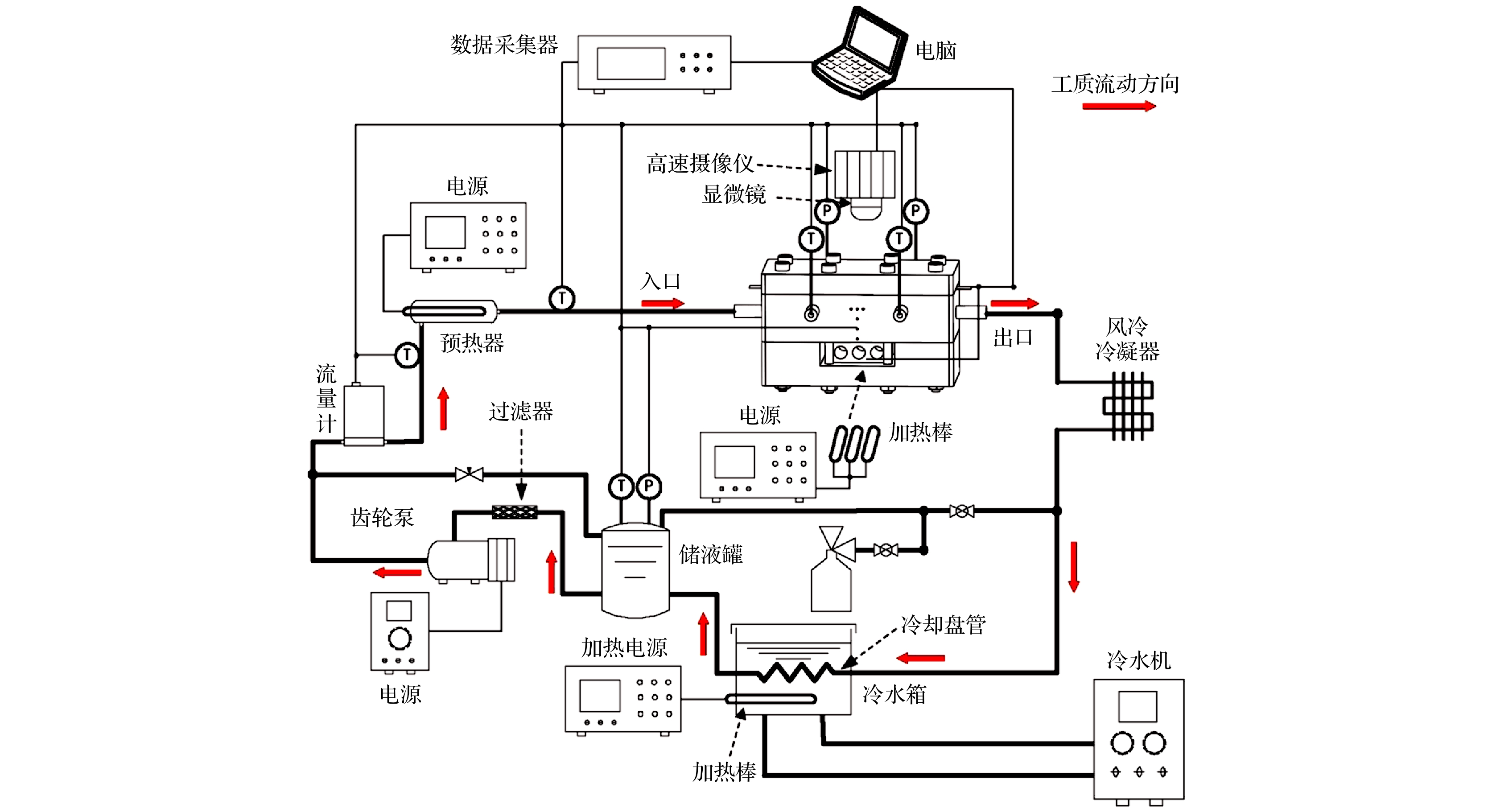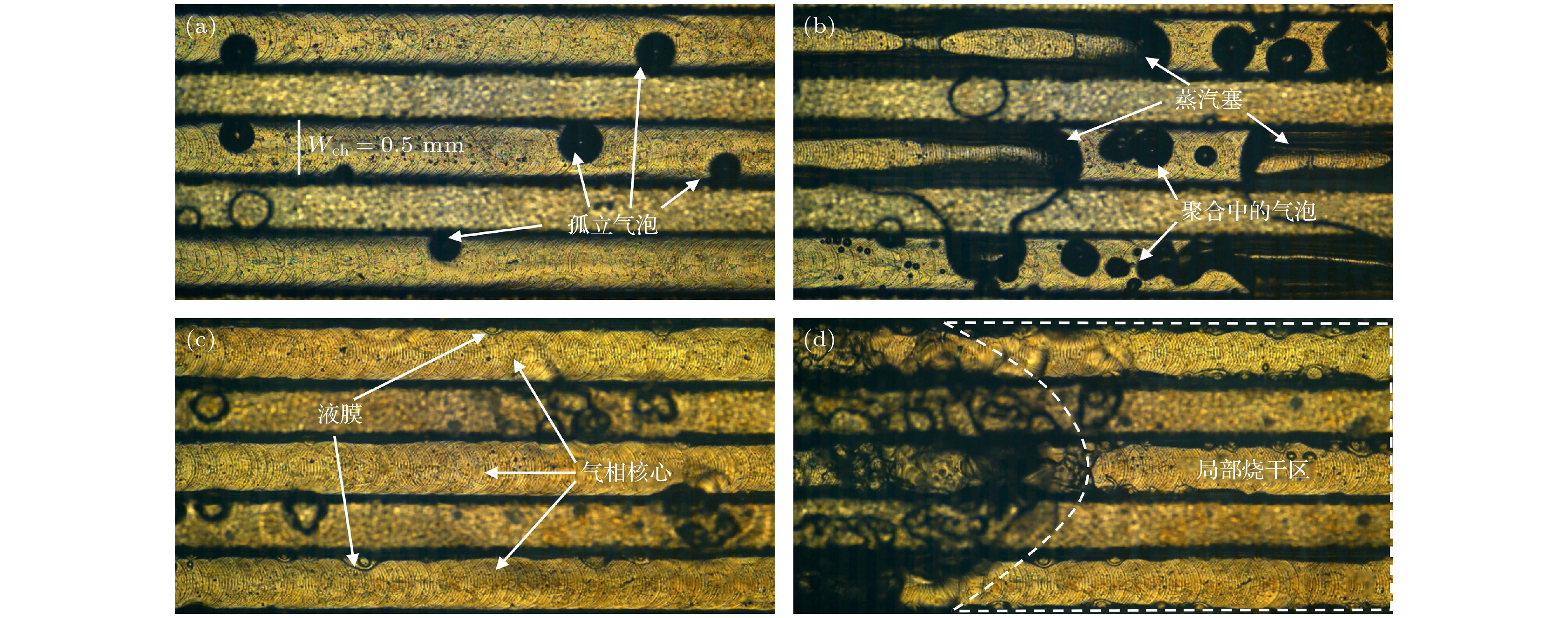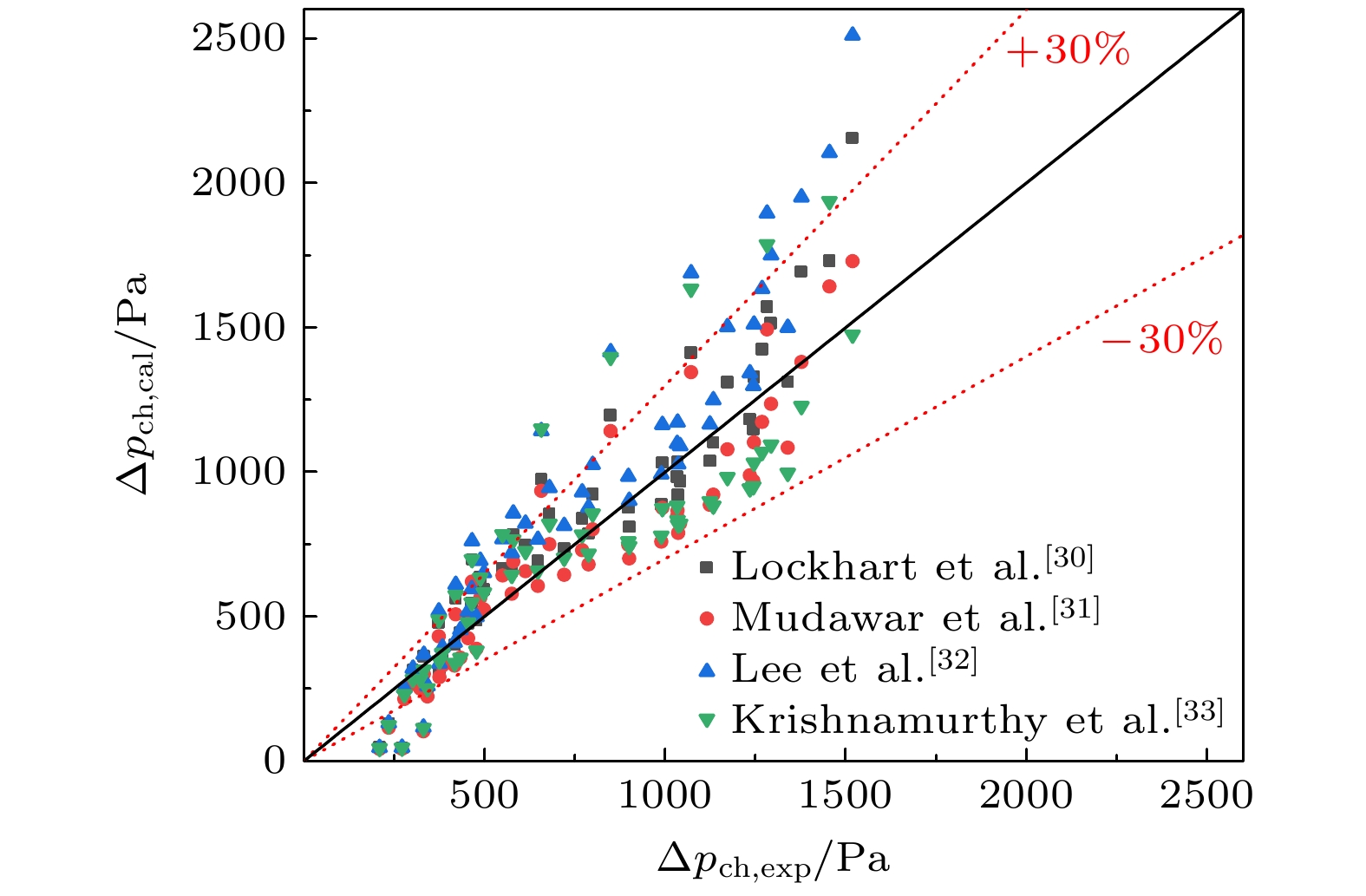-
With the rapid development of microelectronic technology, the integration and power of chip are increasing. Heat dissipation with high heat flux in limited space has become a bottleneck restricting the efficient and stable operation of the microelectronic devices. Flow boiling in microchannel heat sink is one of the most essential candidates for solving this problem. It has been shown that remarkable high heat transfer performance can be achieved through the liquid-to-vapor change process, which can dissipate a large amount of heat from a small area. In addition, dielectric fluorinated fluids, such as HFE-7100, HFE-7200, and FC-72, are especially suitable for cooling microelectronic devices, because of their excellent safety and environmental characteristics. However, dielectric fluorinated fluids have poorer thermophysical properties than water. Thus, the flow boiling heat transfer characteristics of dielectric fluorinated fluids can be different from those of water. In this work, flow boiling heat transfer and flow characteristics of HFE-7100 in a rectangular parallel microchannel are investigated. The tests are conducted at mass fluxes from 88.9 to 277.8 kg·m–2·s–1, inlet subcooling temperature from 20.5 to 35.5 ℃ and effective heat flux from 12 to 279 kW·m–2 at nearly atmospheric pressure. The effects of mass flux, inlet subcooling temperature, effective heat flux and vapor quality are examined and analyzed. Additionally, flow visualization is also obtained to explain the heat transfer mechanism during the experiments. The results show that the boiling hysteresis is observed for HFE-7100 at low inlet subcooling temperature, and the increasing inlet subcooling temperature and mass flux can delay the onset of nucleate boiling. The increases of inlet subcooling temperature and mass flux can enhance the two-phase heat transfer coefficient. And the two-phase heat transfer coefficient is significantly dependent on the inlet subcooling temperature in the slug flow, while it is significantly dependent on the mass flux in the annular flow. The two-phase pressure drop increases drastically as the effective heat flux increases. And the two-phase pressure drops with different mass fluxes at constant vapor quality are obviously different between the slug flow and the annular flow. Furthermore, the experimental data are compared with four predicted values of the literature. It is found that the correlation of Lockhart has the best statistical agreement with an MAE of 19.6% and over 85% of points in the deviation bandwidth of ±30%. The results in this paper give valuable theoretical guidance for designing and optimizing heat dissipation equipment for microelectronic devices. By utilizing HFE-7100 as the coolant and microchannel heat sinks in flow boiling, it is possible to enhance the stability and reliability of the electronic devices. Additionally, the heat transfer performance associated with different heat fluxes can be improved by regulating the inlet subcooling and mass flow rate. Finally, the two-phase pressure drop correlation proposed by Lockhart can be employed to predict the pump power for heat dissipation equipment.
-
Keywords:
- flow boiling /
- microchannel /
- HFE-7100 /
- heat transfer /
- electronic devices
[1] Karayiannis T G, Mahmoud M M 2017 Appl. Therm. Eng. 115 1372
 Google Scholar
Google Scholar
[2] Manetti L L, Ribatski G, de Souza R R, Cardoso E M 2020 Exp. Therm. Fluid Sci. 113 110025
 Google Scholar
Google Scholar
[3] Harirchian T, Garimella S V 2009 Int. J. Multiphase Flow 35 349
 Google Scholar
Google Scholar
[4] Asrar P, Ghiaasiaan S M, Joshi Y K. 2021 J. Heat Transfer 143 023001
 Google Scholar
Google Scholar
[5] 杨晓强, 秋穗正, 贾晓鸿, 尹海峰, 贾斗南, 卢冬华 2007 核动力工程 28 38
 Google Scholar
Google Scholar
Yang X Q, Qiu S Z, Jia X H, Yin H F, Jia D N, Lu D H 2007 Nucl. Power Eng. 28 38
 Google Scholar
Google Scholar
[6] Wang Y, Sefiane K 2012 Int. J. Heat Mass Transfer 55 2235
 Google Scholar
Google Scholar
[7] Al-Zaidi A H, Mahmoud M M, Karayiannis T G 2019 Int. J. Heat Mass Transfer 140 100
 Google Scholar
Google Scholar
[8] Al-Zaidi A H, Mahmoud M M, Karayiannis T G 2021 Int. J. Heat Mass Transfer 164 120587
 Google Scholar
Google Scholar
[9] Cheng X, Wu H 2023 Exp. Therm. Fluid Sci. 142 110805
 Google Scholar
Google Scholar
[10] Yang K S, Jeng Y R, Huang C M, Wang C C 2011 Heat Transfer Eng. 32 697
 Google Scholar
Google Scholar
[11] Tuo H, Hrnjak P 2013 Int. J. Refrig. 36 1263
 Google Scholar
Google Scholar
[12] Rausch M H, Kretschmer L, Will S, Leipertz A, Froba A P 2015 J. Chem. Eng. Data 60 3759
 Google Scholar
Google Scholar
[13] Liang G, Mudawar I 2020 Int. J. Heat Mass Transfer 146 118864
 Google Scholar
Google Scholar
[14] Cui P, Liu Z 2021 Int. J. Heat Mass Transfer 175 121387
 Google Scholar
Google Scholar
[15] Feng S, Yan Y, Lai C 2022 Int. J. Heat Mass Transfer 186 122468
 Google Scholar
Google Scholar
[16] Zhuang X R, Yu P, Li X, Deng Q Y 2020 PRC Patent CN202122664314 [2021-11-02
[17] Abu-Eishah S I 2001 Int. J. Thermophys. 22 1855
 Google Scholar
Google Scholar
[18] Machrafi H, Sadoun N, Rednikov A, Dehaeck S, Dauby P C, Colinet P 2013 Microgravity Sci. Technol. 25 251
 Google Scholar
Google Scholar
[19] Nassar M, Vazquez P, Chauris N, Daaboul M B, Louste C 2020 IEEE Trans. Ind. Appl. 56 4193
 Google Scholar
Google Scholar
[20] Qu W, Siu-Ho A 2008 J. Heat Transfer 130 122402
 Google Scholar
Google Scholar
[21] Blevins R D 1984 Applied Fluid Dynamics Handbook (New York: Van Nostrand Reinhold) pp12–20
[22] Taylor B N, Kuyatt C E 1994 Guidelines for Evaluating and Expressing the Uncertainty of NIST Measurement Results (Gaithersburg: Department of Commerce, Technology Administration, National Institute of Standards and Technology) pp11–20
[23] Žukauskas A 1972 Adv. Heat Transfer 8 93
[24] Chang J Y, Prasher R, Chau D, Myers A, He D 2005 International Electronic Packaging Technical Conference and Exhibition San Francisco, California, USA, July 17–22, 2005 p183
[25] Brunschwiler T, Michel B, Rothuizen H, Kloter U, Wunderle B, Oppermann H, Reichl H 2009 Microsyst. Technol. 15 57
 Google Scholar
Google Scholar
[26] Xu F, Wu H 2018 J. Heat Transfer 140 122401
 Google Scholar
Google Scholar
[27] Kong L J, Liu Z G, Jia L, Lv M M, Liu Y 2020 Exp. Therm. Fluid Sci. 115 109946
 Google Scholar
Google Scholar
[28] Ming H S, Ma J, Bu X W 1993 Int. J. Heat Mass Transfer 36 4461
 Google Scholar
Google Scholar
[29] Zhuang X R, Xie Y C, Li X, Yue S J, Wang H T, Wang H D, Yu P 2023 Appl. Therm. Eng. 225 120180
 Google Scholar
Google Scholar
[30] Lockhart W R 1949 Chem. Eng. Prog. 45 39
[31] Mudawar I, Qu W 2003 Int. J. Heat Mass Transfer 46 2737
 Google Scholar
Google Scholar
[32] Lee H J, Lee S Y 2001 Int. J. Multiphase Flow 27 2043
 Google Scholar
Google Scholar
[33] Krishnamurthy S, Peles Y 2007 Phys. Fluids 19 043302
 Google Scholar
Google Scholar
-
图 5 G = 155.6 kg·m–2·s–1和∆Tsub = 25.5 ℃下, HFE-7100的沸腾两相流动形态 (a) 泡状流 (qeff = 90.6 kW·m–2); (b) 塞状流 (qeff = 110.6 kW·m–2); (c) 环状流 (qeff = 202.3 kW·m–2); (d) 局部烧干状态 (qeff = 263.4 kW·m–2)
Figure 5. Boiling two-phase flow patterns of HFE-7100 at G = 155.6 kg·m–2·s–1 and ∆Tsub = 25.5℃: (a) Bubbly flow (qeff = 90.6 kW·m–2); (b) slug flow (qeff = 110.6 kW·m–2); (c) annular flow (qeff = 202.3 kW·m–2); (d) local drying state (qeff = 263.4 kW·m–2).
表 1 测量参数的不确定度
Table 1. Uncertainty of measurement parameters.
测量参数 测试设备 测量范围 不确定度 温度 Omega T/K 0—300 ℃ ±0.2 ℃ 压力 Star CYYZ11 0—0.4 MPa ±0.1% 压差 Star CCY15 0—20 kPa ±0.25% 质量流量 Bronkhorst MINI CORI-FLOW M14 0.3—15 kg·h–1 ±0.2% 长度 LINKS游标卡尺 0—150 mm ±0.01 mm 两相热流密度 — — 2.2%—9.1% 两相传热系数 — — 2.5%—9.7% 干度 — — 1.7%—6.3% 表 2 两相压降关联式计算结果与实验结果的对比
Table 2. Comparison between the calculated results of the two-phase pressure drop correlation and the experimental results
文献 两相压降关联式 MAE/% δ/% [30] $ {X_{vv}} = {\left( {\dfrac{{{\mu _{{\text{l, out, t}}}}}}{{{\mu _{{\text{g, out, t}}}}}}} \right)^{0.274}}{\left( {\dfrac{{1 - {x_{{\text{out }}}}}}{{{x_{{\text{out }}}}}}} \right)^{0.727}}{\left( {\dfrac{{{\text{ }}R{e_{{\text{g, out, t}}}}}}{{R{e_{{\text{l, out, t}}}}}}} \right)^{0.5}} $, ${f_{\text{l}}} = \dfrac{{20.09}}{{Re_{{\text{l, out}}\;}^{0.547}}}$ 19.6 85.5 $\phi _{\text{f}}^2 = 1 + \dfrac{5}{{{X_{vv}}}} + \dfrac{1}{{X_{vv}^2}}$, $\Delta {p_{{\text{ch, cal}}}} = \dfrac{{2{f_{\text{l}}}{G^2}\phi _{\text{f}}^2\left( {L - {S_{\text{L}}}} \right)}}{{3{\rho _{\text{l}}}{D_{{\text{ch}}}}}}\left( {x_{{\text{out}}\;}^2 - 3{x_{{\text{out}}\;}} + 3} \right)$ [31] $ {X_{vv}} = {\left( {\dfrac{{{\mu _{{\text{l, out, t}}}}}}{{{\mu _{{\text{g, out, t}}}}}}} \right)^{0.274}}{\left( {\dfrac{{1 - {x_{{\text{out }}}}}}{{{x_{{\text{out }}}}}}} \right)^{0.727}}{\left( {\dfrac{{{\text{ }}R{e_{{\text{g, out, t}}}}}}{{R{e_{{\text{l, out, t}}}}}}} \right)^{0.5}} $, ${f_{\text{l}}} = \dfrac{{20.09}}{{Re_{{\text{l, out, t}}}^{{0}{.547}}}}$ 20.6 85.5 ${C_{\text{M}}} = 21\left( {1 - {{\text{e}}^{ - 319{D_{{\text{fin}}}}}}} \right)\left( {0.00418 G + 0.0613} \right)$, $\phi _{\text{f}}^2 = 1 + \dfrac{{{C_{\text{M}}}}}{{{X_{vv}}}} + \dfrac{1}{{X_{vv}^2}}$ $\Delta {p_{{\text{ch, cal}}}} = \dfrac{{2{f_{\text{l}}}{G^2}\phi _{\text{f}}^2\left( {L - {S_{\text{L}}}} \right)}}{{3{\rho _{\text{l}}}{D_{{\text{ch}}}}}}\left( {x_{{\text{out}}\;}^2 - 3{x_{{\text{out}}\;}} + 3} \right)$ [32] $ {X_{vv}} = {\left( {\dfrac{{{\mu _{{\text{l, out, t}}}}}}{{{\mu _{{\text{g, out, t}}}}}}} \right)^{0.274}}{\left( {\dfrac{{1 - {x_{{\text{out }}}}}}{{{x_{{\text{out }}}}}}} \right)^{0.727}}{\left( {\dfrac{{{\text{ }}R{e_{{\text{g, out, t}}}}}}{{R{e_{{\text{l, out, t}}}}}}} \right)^{0.5}} $, ${f_{\text{l}}} = \dfrac{{20.09}}{{Re_{{\text{l, out, t}}}^{{0}{.547}}}}$ 27.8 63.6 ${C_{\text{L}}} = 2566{G^{0.5466}}D_{{\text{ch}}}^{0.8819}\left( {1 - {{\rm e} ^{ - 319{D_{{\text{ch}}}}}}} \right)$, $\phi _{\text{f}}^2 = 1 + \dfrac{{{C_{\text{L}}}}}{{{X_{vv}}}} + \dfrac{1}{{X_{vv}^2}}$ $\Delta {p_{{\text{ch, cal}}}} = \dfrac{{2{f_{\text{l}}}{G^2}\phi _{\text{f}}^2\left( {L - {S_{\text{L}}}} \right)}}{{3{\rho _{\text{l}}}{D_{{\text{ch}}}}}}\left( {x_{{\text{out}}\;}^2 - 3{x_{{\text{out}}\;}} + 3} \right)$ [33] $ {X_{vv}} = {\left( {\dfrac{{{\mu _{{\text{l, out, t}}}}}}{{{\mu _{{\text{g, out, t}}}}}}} \right)^{0.274}}{\left( {\dfrac{{1 - {x_{{\text{out }}}}}}{{{x_{{\text{out }}}}}}} \right)^{0.727}}{\left( {\dfrac{{{\text{ }}R{e_{{\text{g, out, t}}}}}}{{R{e_{{\text{l, out, t}}}}}}} \right)^{0.5}} $, ${f_{\text{l}}} = \dfrac{{20.09}}{{Re_{{\text{l, out, t}}}^{0.547}}}$ 25.5 74.5 ${C_{\text{K}}} = \dfrac{{0.0358}}{{Re_{{\text{l, out, t}}}^{{0}{.547}}}}$, $\phi _{\text{f}}^2 = 1 + \dfrac{{{C_{\text{K}}}}}{{{X_{vv}}}} + \dfrac{1}{{X_{vv}^2}}$ $\Delta {p_{{\text{ch, cal}}}} = \dfrac{{2{f_{\text{l}}}{G^2}\phi _{\text{f}}^2\left( {L - {S_{\text{L}}}} \right)}}{{3{\rho _{\text{l}}}{D_{{\text{ch}}}}}}\left( {x_{{\text{out}}\;}^2 - 3{x_{{\text{out}}\;}} + 3} \right)$ -
[1] Karayiannis T G, Mahmoud M M 2017 Appl. Therm. Eng. 115 1372
 Google Scholar
Google Scholar
[2] Manetti L L, Ribatski G, de Souza R R, Cardoso E M 2020 Exp. Therm. Fluid Sci. 113 110025
 Google Scholar
Google Scholar
[3] Harirchian T, Garimella S V 2009 Int. J. Multiphase Flow 35 349
 Google Scholar
Google Scholar
[4] Asrar P, Ghiaasiaan S M, Joshi Y K. 2021 J. Heat Transfer 143 023001
 Google Scholar
Google Scholar
[5] 杨晓强, 秋穗正, 贾晓鸿, 尹海峰, 贾斗南, 卢冬华 2007 核动力工程 28 38
 Google Scholar
Google Scholar
Yang X Q, Qiu S Z, Jia X H, Yin H F, Jia D N, Lu D H 2007 Nucl. Power Eng. 28 38
 Google Scholar
Google Scholar
[6] Wang Y, Sefiane K 2012 Int. J. Heat Mass Transfer 55 2235
 Google Scholar
Google Scholar
[7] Al-Zaidi A H, Mahmoud M M, Karayiannis T G 2019 Int. J. Heat Mass Transfer 140 100
 Google Scholar
Google Scholar
[8] Al-Zaidi A H, Mahmoud M M, Karayiannis T G 2021 Int. J. Heat Mass Transfer 164 120587
 Google Scholar
Google Scholar
[9] Cheng X, Wu H 2023 Exp. Therm. Fluid Sci. 142 110805
 Google Scholar
Google Scholar
[10] Yang K S, Jeng Y R, Huang C M, Wang C C 2011 Heat Transfer Eng. 32 697
 Google Scholar
Google Scholar
[11] Tuo H, Hrnjak P 2013 Int. J. Refrig. 36 1263
 Google Scholar
Google Scholar
[12] Rausch M H, Kretschmer L, Will S, Leipertz A, Froba A P 2015 J. Chem. Eng. Data 60 3759
 Google Scholar
Google Scholar
[13] Liang G, Mudawar I 2020 Int. J. Heat Mass Transfer 146 118864
 Google Scholar
Google Scholar
[14] Cui P, Liu Z 2021 Int. J. Heat Mass Transfer 175 121387
 Google Scholar
Google Scholar
[15] Feng S, Yan Y, Lai C 2022 Int. J. Heat Mass Transfer 186 122468
 Google Scholar
Google Scholar
[16] Zhuang X R, Yu P, Li X, Deng Q Y 2020 PRC Patent CN202122664314 [2021-11-02
[17] Abu-Eishah S I 2001 Int. J. Thermophys. 22 1855
 Google Scholar
Google Scholar
[18] Machrafi H, Sadoun N, Rednikov A, Dehaeck S, Dauby P C, Colinet P 2013 Microgravity Sci. Technol. 25 251
 Google Scholar
Google Scholar
[19] Nassar M, Vazquez P, Chauris N, Daaboul M B, Louste C 2020 IEEE Trans. Ind. Appl. 56 4193
 Google Scholar
Google Scholar
[20] Qu W, Siu-Ho A 2008 J. Heat Transfer 130 122402
 Google Scholar
Google Scholar
[21] Blevins R D 1984 Applied Fluid Dynamics Handbook (New York: Van Nostrand Reinhold) pp12–20
[22] Taylor B N, Kuyatt C E 1994 Guidelines for Evaluating and Expressing the Uncertainty of NIST Measurement Results (Gaithersburg: Department of Commerce, Technology Administration, National Institute of Standards and Technology) pp11–20
[23] Žukauskas A 1972 Adv. Heat Transfer 8 93
[24] Chang J Y, Prasher R, Chau D, Myers A, He D 2005 International Electronic Packaging Technical Conference and Exhibition San Francisco, California, USA, July 17–22, 2005 p183
[25] Brunschwiler T, Michel B, Rothuizen H, Kloter U, Wunderle B, Oppermann H, Reichl H 2009 Microsyst. Technol. 15 57
 Google Scholar
Google Scholar
[26] Xu F, Wu H 2018 J. Heat Transfer 140 122401
 Google Scholar
Google Scholar
[27] Kong L J, Liu Z G, Jia L, Lv M M, Liu Y 2020 Exp. Therm. Fluid Sci. 115 109946
 Google Scholar
Google Scholar
[28] Ming H S, Ma J, Bu X W 1993 Int. J. Heat Mass Transfer 36 4461
 Google Scholar
Google Scholar
[29] Zhuang X R, Xie Y C, Li X, Yue S J, Wang H T, Wang H D, Yu P 2023 Appl. Therm. Eng. 225 120180
 Google Scholar
Google Scholar
[30] Lockhart W R 1949 Chem. Eng. Prog. 45 39
[31] Mudawar I, Qu W 2003 Int. J. Heat Mass Transfer 46 2737
 Google Scholar
Google Scholar
[32] Lee H J, Lee S Y 2001 Int. J. Multiphase Flow 27 2043
 Google Scholar
Google Scholar
[33] Krishnamurthy S, Peles Y 2007 Phys. Fluids 19 043302
 Google Scholar
Google Scholar
Catalog
Metrics
- Abstract views: 8556
- PDF Downloads: 501
- Cited By: 0















 DownLoad:
DownLoad:









